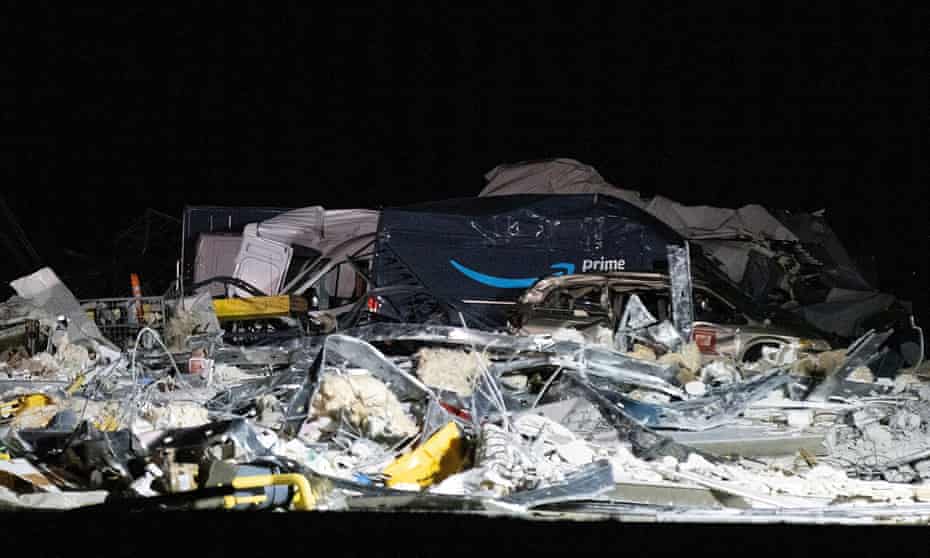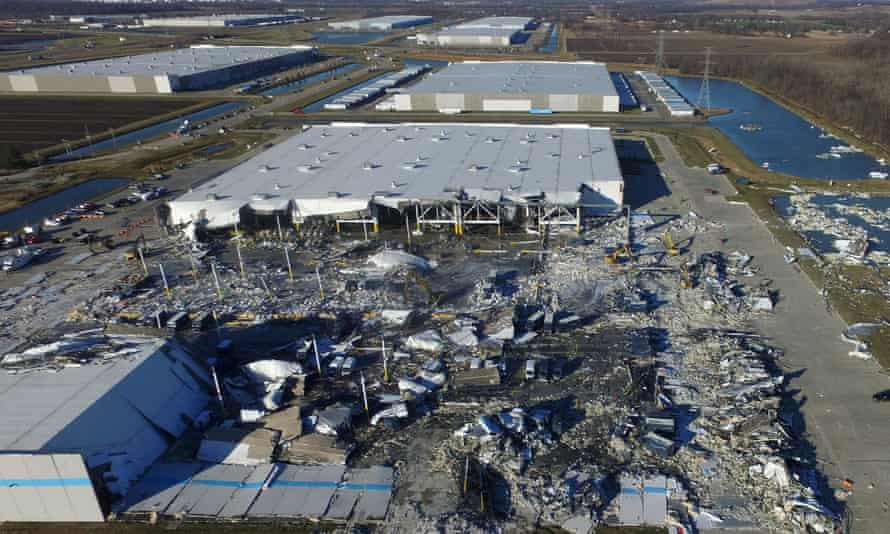
Questions over worker safety at Amazon are intensifying once again after a tornado struck an Amazon warehouse in Edwardsville, Illinois, on Friday, leaving six people dead and another hospitalized.
On Monday, the federal Occupational Health and Safety Administration said it opened a workplace safety investigation into the warehouse collapse. Meanwhile, workers and activists are calling for more action.
Concerns over labor rights at the e-commerce giant have been mounting, exacerbated by allegations the company failed to “adequately notify” workers and health officials of Covid-19 cases.
“This incident calls into question so much of Amazon’s practices in their warehouses,” said Marcos Ceniceros, an organizer at Warehouse Workers for Justice. “This is not the first time we’ve seen workers suffer at Amazon and we want to make sure that they’re not continuing to cut corners and putting workers at risk.”
Warehouse Workers for Justice has called for a hearing in the Illinois state legislature examining what led to the deaths at Amazon’s warehouse. They are also calling on the company to ensure it has safety and training protocols in place for extreme weather events and other risks, like Covid-19, in the future.
Speaking to the Intercept on Monday, 12 Amazon workers described concerns over workplace safety. Some said they had never experienced a tornado or fire drill on the job, and several said they would be uncertain of what to do in an emergency.
John Gasper, associate professor of economics at Carnegie Mellon University’s Tepper School of Business, cautioned that he didn’t know the particulars of what happened at Amazon. But he said for companies like Amazon that have high turnover in labor, it likely is harder to conduct regular emergency training schedules, particularly during the busy holiday season when there are many seasonal workers.
“The cost of the time to do the drills is also time they are not [moving] the packages,” he said. “They have to think about these tradeoffs. But I don’t think any company wants to harm its employees.”

Amazon said workers at the warehouse had little time to prepare when the National Weather Service declared a tornado warning on Friday night. The tornado arrived soon after, collapsing both sides of the warehouse and caving in its roof.
“There was a tremendous effort that happened that night to keep everybody safe,” said John Felton, Amazon’s senior vice-president of global delivery services, speaking alongside the Illinois governor, JB Pritzker, in Edwardsville on Monday and pledging a review of all the events that took place Friday.
An Amazon spokesperson, Kelly Nantel, said the warehouse received tornado warnings between 8.06pm and 8.16pm on Friday and site leaders directed workers to immediately take shelter. At 8.27pm, the tornado struck the building.
Felton said most of the 46 people in the warehouse known as a “delivery station” headed to a shelter on the north side, which ended up “nearly undamaged” and a smaller group to the harder-hit south end. The company said those are not separate safe rooms, but generally places away from windows considered safer than other parts of the plant.
Amazon has pledged to assist workers and their families affected by the tragedy, including donating $1m to the Edwardsville Community Foundation. The company declined to answer questions on Monday about its disaster plans at the plant, including whether employees were required to perform drills.
The tornado that hit Amazon’s facility was part of a swarm of twisters across the midwest and south that leveled entire communities. Another tornado destroyed a candle factory in Mayfield, Kentucky, killing multiple workers on an overnight shift. Osha, which is part of the US Department of Labor, said federal investigators were not investigating the Kentucky factory collapse because the state has its own workplace safety agency.
Ceniceros said as extreme weather intensifies due to the climate crisis, hange, workers are investigating how to protect themselves and hold corporations accountable.
The Edwardsville warehouse is part of a vast patchwork of concrete-and-steel structures that have popped up in the St. Louis region over the past decade, drawn by its confluence of major highways and railroads, cheap costs and Americans’ expectations for getting packages delivered soon after they click a link to order them.

A researcher who studies the warehouse industry and the pressure put on Amazon workers to meet strict productivity quotas said even if Amazon’s team did everything right in responding to a devastating tornado, it raises the question about the structure of enormous warehouses popping up across the midwest as some climate experts warn of more frequent and severe storms.
“We don’t think of warehousing as one of the industries that’s going to be severely impacted by climate change but then you have a case like this,” said Beth Gutelius, research director at the Center for Urban Economic Development at the University of Illinois-Chicago.
At the governor’s press conference Monday, Nantel emphasized that the 1.1m sq ft building was “constructed consistent with code”.
But Pritzker raised the possibility that current codes aren’t enough to meet the dangers of increasingly devastating storms. He said there will be an investigation into updating code ,“given serious change in climate that we are seeing across the country”.
Marc Wulfraat, a supply chain consultant who has studied Amazon’s warehouses and distribution centers, says the one in Edwardsville appeared standard for the industry with 40ft concrete walls, not unlike many others popping up around the country as consumers shift from stores to online buying.
“It was basically a warehouse, with nothing particularly distinctive to Amazon,” said Wulfratt, president of MWPVL International, a consultancy in Montreal. “They abide by code when they put these buildings up. There is no way around it.”
Gutelius said she couldn’t help but view the tragedy as a spillover effect of American consumer demand for getting packages shipped quickly.
“Yes, it was a freak accident, but the facts are still that these workers were making sure my dog gets a frisbee – tomorrow – and gave their life for it,” she said. “It seems really kind of ridiculous when you think about what the stakes are.”
[“source=theguardian”]
